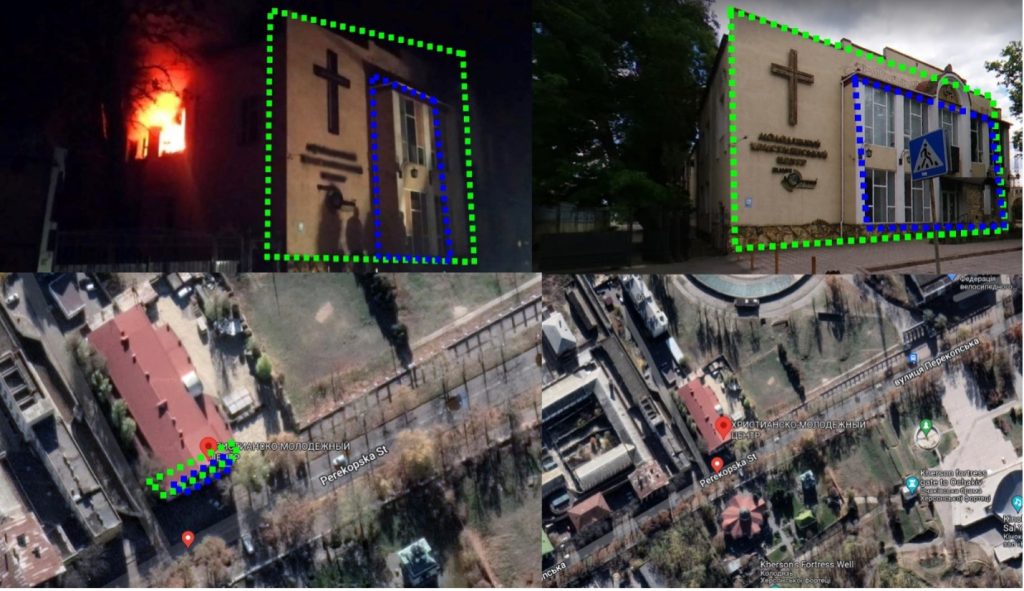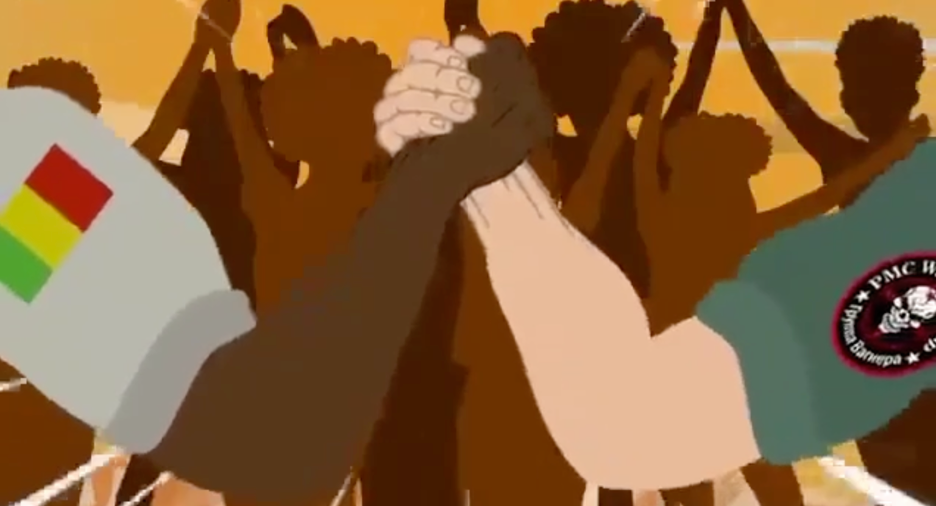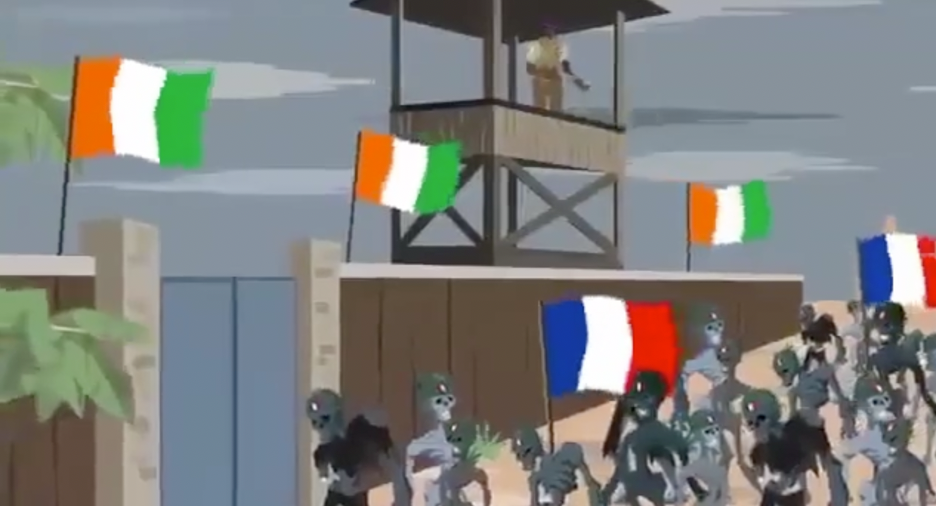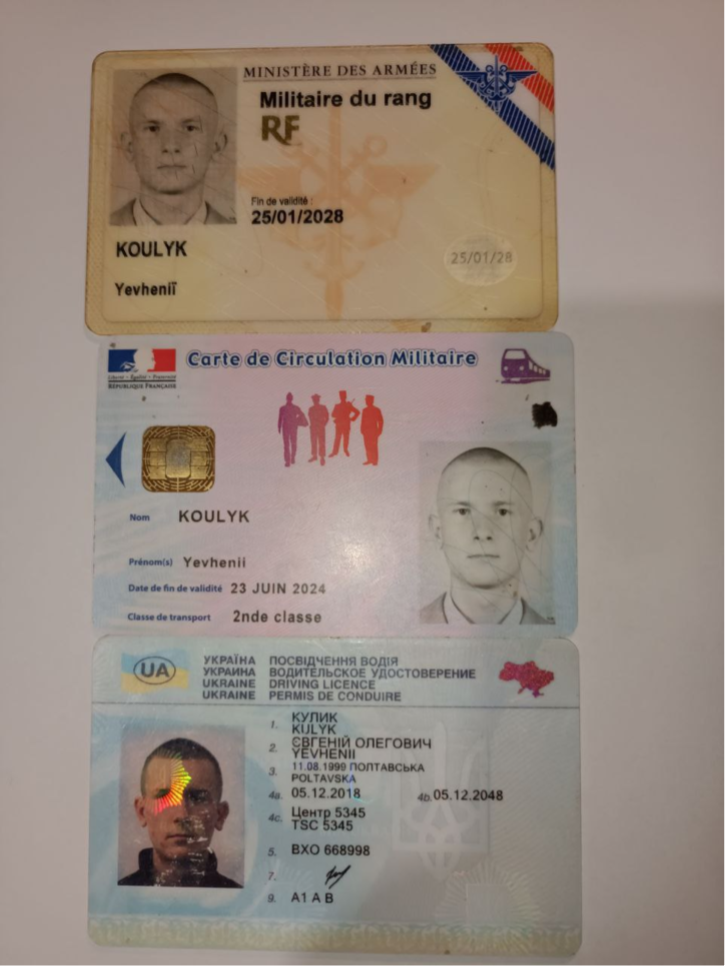As Russia continues its assault on Ukraine, the Atlantic Council’s Digital Forensic Research Lab (DFRLab) is keeping a close eye on Russia’s movements across the military, cyber, and information domains. With more than seven years of experience monitoring the situation in Ukraine, as well as Russia’s use of propaganda and disinformation to undermine the United States, NATO, and the European Union (EU), DFRLab’s global team presents the latest installment of the Russian War Report.
Click to jump to an entry:
Security
Reports emerge of internal power struggles between Wagner and Russian defense ministry
Russian forces allegedly use incendiary munitions in Kherson, youth center burns
Missile fragments, rocket warhead fall on Moldovan territory
Tracking narratives
Animation depicts Wagner forces fighting French “zombies” in West Africa
Flurry of conflicting theories circulate among pro-Kremlin sources following deadly helicopter crash
Belarusian state TV accuses Ukrainian embassy of recruiting foreign fighters
International response
Serbian president accuses Wagner of recruiting Serbian citizens
Ukraine’s allies continue to send military aid, including heavy equipment
Reports emerge of internal power struggles between Wagner and Russian defense ministry
On January 13, the Russian Ministry of Defense (MoD) claimed its forces had taken control of Soledar and could encircle Bakhmut, threatening Ukrainian supply lines. In the statement, the MoD praised the efforts of aviation, artillery, and airborne troops, but did not mention the notable role Wagner played in securing Soledar.
Moscow’s announcement highlighted a long-simmering tension between Wagner and the official structure of the Russian MoD. On January 17, an old letter written by Valery Gerasimov, commander of Russian forces in Ukraine, re-circulated online. The letter, dated December 29, 2022, stated that Wagner is not included in the structure of the Russian armed forces. Gerasimov wrote the letter in response to an inquiry to the Russian MoD made by Evgeny Stupin, a lawyer for the Moscow City Duma. On January 15, President Vladimir Putin also attributed the Soledar success to the MoD.
On the day that Russia claimed Soledar, military bloggers affiliated with the Kremlin claimed there was an ongoing conflict between the MoD and Wagner founder Yevgeny Prigozhin. On January 15, Prigozhin awarded medals to Wagner soldiers for the capture of Soledar. On January 16, Kremlin spokesperson Dmitry Peskov dispelled reports of an ongoing conflict between Prigozhin and Russian army command, claiming the reports are “products of information manipulation.” Later in the day, when asked about Peskov’s comments, Prigozhin also dispelled the reports, saying, “I see no reason not to trust Peskov.”
On January 19, Prigozhin said that Wagner soldiers were concentrating on taking the suburban city of Klishchiivka, south of Bakhmut. This information has yet to be confirmed by the Russian MoD.
Elsewhere, on January 14, Ukrainian officials reported that Russia conducted fifty missile and three air strikes against Kyiv, Kharkiv, Odesa, Kryvyi Rih, Dnipro, Vinnytsia, and other settlements in West Ukraine. Ukrainian forces said that Russia used S-300 and S-400 systems against ground targets in Kyiv in the morning and later launched high-precision weapons, including twenty-eight cruise missile strikes using Kh-101, Kh-555, and Kh-59 guided air missiles and the sea-based 3M-14 Kalibr.
In Marinka, the Ukrainian army repelled renewed Russian attacks on January 17 and 18. Russian forces have been storming the settlement since last March, resulting in widespread destruction. The Russian forces also conducted raids in the area of Bilohorivka in Luhansk oblast and Krasna Hora, Bakhmut, Klischiyivka, Vodyane, Nevelske, and Pobieda in Donetsk oblast.
Chechen volunteer forces have become increasingly active in the fight around Bakhmut. There are at least two battalions of Chechens—the Sheikh Mansur Battalion and Dzhokhar Dudayev Battalion—fighting for the Ukrainian army on the Bakhmut frontline. On a tactical level, the Chechen battalions are working together in some areas, like in Opytne, where they attacked Russian positions. The Dzhokhar Dudayev Battalion also maintains a reconnaissance unit, “Adam,” currently located in Donetsk oblast.
On January 16, a Russian rocket struck a civilian building in Dnipro, killing at least forty-five people, including six children, marking the single deadliest civilian attack since the war began. Ukraine said it does not have air-defense systems that can intercept Russian KH-22 missiles; to ward off future missiles would require Western partners to donate advanced air defenses such as the US MIM-104 Patriot missile system.
—Ruslan Trad, resident fellow for security research, Sofia, Bulgaria
—Valentin Châtelet, research associate, Brussels, Belgium
Russian forces allegedly use incendiary munitions in Kherson, youth center burns
On January 18, Russian shelling intensified on the southern frontline in Ukraine, which stretches from Kamianske in the Zaporizhzhia region to Vuhledar in the south of Donetsk oblast. After a night of heavy shelling, videos and photos emerged online showing that the Russian army had used what appears to incendiary ammunition in city of Kherson and nearby Beryslav.
The morning after the strike, videos and photos shared online showed the resulting damage. A local Kherson newspaper reported that a religious youth center had burned down as a result of the shelling. The DFRLab geolocated the youth center and confirmed that it was along the pathway of the airstrike but cannot confirm whether incendiary munitions were involved.
 Top left: Screenshot of footage showing the burning youth center. Top right: Google Street View image of the youth center prior to the incident. Bottom left: Google map view of the building from above. Bottom right: Google map view from a higher altitude. Green boxes show the front of the building while blue boxes show the building’s windows. (Source: Kherson Online, top left; Google Maps, top right, bottom left, and bottom right)
Top left: Screenshot of footage showing the burning youth center. Top right: Google Street View image of the youth center prior to the incident. Bottom left: Google map view of the building from above. Bottom right: Google map view from a higher altitude. Green boxes show the front of the building while blue boxes show the building’s windows. (Source: Kherson Online, top left; Google Maps, top right, bottom left, and bottom right)
—Valentin Châtelet, research associate, Brussels, Belgium
Missile fragments, rocket warhead fall on Moldovan territory
Fragments of a Russian missile targeting Ukraine fell on Moldova territory on January 14 in the town of Larga, Briceni district. According to Moldova’s Ministry of Internal Affairs, a warhead fueled with approximately eighty kilograms of explosive material was also discovered among the debris. The next day, authorities reported that specialist teams had carried out controlled detonations of the remaining explosives. The Ministry of Defense noted that the army’s aerial surveillance system did not record a violation of Moldovan airspace, however.
Authorities in Chisinau have strongly condemned the attacks on neighboring Ukraine. “This is the reality of war, imposed by the aggressor, right here in our region,” stressed Moldovan President Maia Sandu. “The missiles reach Moldova as well—the fragments discovered yesterday in the Briceni district testify to this. We strongly condemn Russia’s aggression against Ukraine. Attacks on urban infrastructure and the killing of civilians are war crimes; they have no justification.”
Prime Minister Natalia Gavrilita also condemned Russia’s January 14 missile attacks on Ukrainian cities. “There is no political, historical, and even more so moral justification for killing civilians and attacking the infrastructure that ensures the survival of the population,” she said. “I express my deep indignation at the new massive attack on Ukraine. I express my support for the heroic Ukrainian people and our support for the victims of Russia’s barbaric attacks.”
This is the third time missile fragments have landed in Moldova, which is not a member of the European Union or NATO. On December 5, Moldovan border police discovered a missile in an orchard, also in the Briceni district. In October 2022, a Russian missile shot down by a Ukrainian anti-aircraft system fell in the village of Naslavcea, located along the border with Ukraine, shattering windows of several residences as a result of the explosion.
—Victoria Olari, research assistant, Chisinau, Moldova
Animation depicts Wagner forces fighting French “zombies” in West Africa
An animated video showing a Wagner operative helping West African countries defeat zombie French soldiers began circulating on social media and pro-Kremlin Telegram channels this week. While the origin of the video is currently unknown, it appears to have first shown up on Twitter on January 14th, then migrated to alternative video platforms before being shared across pro-Russian Telegram channels.
Après le rat, une nouvelle animation où le groupe #WagnerGroup apparaît en sauveur du #Mali et #BurkinaFaso contre la #France qui est cette fois dépeinte comme un serpent / new anti French / pro #WagnerGroup cartoon emerging on social media https://t.co/Nxi5Esn2Oo
— alleyesonwagner (@alleyesonwagner) January 14, 2023
By depicting Wagner forces as heroes, the video promotes a pro-Russian, anti-French narrative that has spread in recent years across West African social media. The animation depicts Wagner soldiers assisting local militaries in Mali and Burkina Faso in removing French forces, represented in the animation as hordes of zombies and a giant cobra. In Mali, a Wagner operative parachutes into the zombie horde and provides ammunition to a Malian soldier who is subsequently able to defeat the undead, while in Burkina Faso, Wagner provides a rocket-propelled grenade to kill the French cobra.
 A screenshot of the video shows a Malian soldier and Wagner operative grasping hands after successfully defeating French zombies, likely an homage to the Arnold Schwarzenegger film Predator and the many memes it spawned.
A screenshot of the video shows a Malian soldier and Wagner operative grasping hands after successfully defeating French zombies, likely an homage to the Arnold Schwarzenegger film Predator and the many memes it spawned.
Russia’s involvement in West Africa does not come in the form of simple weapons deliveries, however. Recent reports indicate that since Russia’s deployment in Mali more than one year ago, violence against civilians has significantly increased, and extremist forces have grown stronger.

 The final shots of the animated video show Wagner operatives driving from Burkina Faso to Côte d’Ivoire, which is also under siege by French zombies.
The final shots of the animated video show Wagner operatives driving from Burkina Faso to Côte d’Ivoire, which is also under siege by French zombies.
The video ends with Wagner forces heading towards Côte d’Ivoire, where French zombies overwhelm an Ivorian soldier. The imagery implies that Wagner aims to send forces to the coastal country.
This is not the first time Wagner has created animated propaganda. In another animation, France was represented as a rat killed by Wagner. And in a comic strip spread in Central African Republic (CAR), Wagner operatives are again depicted fighting zombies, however in the case of CAR the zombies do not represent the French.
Support for France has declined significantly in Francophone Africa, while calls for Russian assistance to fight jihadists has increased.
—Tessa Knight, research associate, London, United Kingdom
Flurry of conflicting theories circulate among pro-Kremlin sources following deadly helicopter crash
On January 18, a helicopter crash in Brovary, near Kyiv, killed sixteen people, including three children, Ukraine’s interior minister, his deputy, and the ministry secretary. The helicopter crashed near a kindergarten. Ukrainian security services investigating the crash are considering three possible scenarios, including a violation of flight rules, a technical malfunction, or intentional sabotage. In the meantime, pro-Kremlin sources are already sharing conflicting narratives about the incident.
One of the first narratives to emerge suggested that Ukraine’s air-defense systems shot down the helicopter. The claim was amplified by pro-Kremlin TV host Olga Skabeyeva on her Telegram channel. Another pro-Kremlin Telegram channel added more details to the claim, saying that “unofficial Ukrainian sources” said the aircraft was shot down by the Stinger or Igla air-defense systems. The claim was also shared on Twitter by a pro-Kremlin account, spreading the narrative to English-speaking audiences. At the time of writing, the English tweet had more than one million views.
Ukrainian air defense shot down Ukrainian helicopter with Ukrainian Minister of Internal Affairs and his deputy onboard. The helicopter crashed in residential area, killing 16 people, incl 2 children. pic.twitter.com/5bFn7jc8Dg
— Vera Van Horne (@VeraVanHorne) January 18, 2023
Other sources took the claim further. The pro-Kremlin Russian outlet Regnum hypothesized that Ukrainian President Volodymyr Zelenskyy was behind the crash, publishing a story with the headline, “The crash of the helicopter of the Ministry of Internal Affairs of Ukraine in Brovary – executed by Zelenskyy?”
Meanwhile, pro-Kremlin reporter Sasha Kots reported that European countries had suspended the helicopter model, either a Eurocopter EC225 Super Puma or a H225M, after a 2016 crash in Norway. While it is true that the European Aviation Safety Agency grounded both aircraft type after the Norway crash, it allowed flights to resume roughly six months later. Helicopters of this type are used by both military and civilian operators in France, Brazil, Vietnam, and many other countries. Kots also claimed that after the two models were grounded, France sold its supply to Ukraine, implying that France is also responsible for the tragedy.
In December 2021, Romania and Ukraine entered into an agreement to upgrade five of these helicopter models.
—Roman Osadchuk, research associate
Belarusian state TV accuses Ukrainian embassy of recruiting foreign fighters
On January 16, the state-controlled TV channel Belarus 1 reported that Belarusian security services had arrested Georgian citizen Giorgi Zirakishvili for allegedly trying to enter Ukraine via Belarus to fight against Russia. Belarus 1 reported that the Ukrainian Embassy in Georgia had advised Zirakishvili to travel from Georgia to Ukraine through Belarus. The broadcaster also claimed that Zirakishvili had planned to meet Igor Kizim, Ukraine’s ambassador to Belarus, upon arrival to receive instructions on how to reach Ukraine and join the Georgian Legion, a paramilitary unit mostly comprised of ethnically Georgian volunteers who fight for Ukraine. Belarus 1 also broadcast an alleged recording of a phone conversation in which Zirakishvili believes he is speaking to representatives from the Ukrainian embassy in Belarus. However, Belarus 1 reported that Zirakishvili was actually speaking to representatives from Belarusian security services, who discovered Zirakishvili’s alleged intentions and connected with him by impersonating Ukrainian embassy staff. The report also contains a video recording of Zirakishvili’s meeting with representatives from Belarusian security services, who he apparently believed were representatives of the Ukrainian embassy.
Belarus 1 did not provide any concrete evidence that Zirakishvili had communicated with anyone from the Ukrainian embassy in Belarus. Despite this, the report claims that Kizim is actively recruiting foreign fighters to send to Ukraine. The ambassador responded to the allegations, saying the Belarus 1 story was “nonsense” and “lies, manipulation, and hypocrisy.” He added that the Ukrainian embassy was in contact with the Belarusian foreign affairs ministry regarding the matter.
—Givi Gigitashvili, research associate, Warsaw, Poland
Russian media amplify and exploit Wagner story about French Foreign Legion deserter killed in Ukraine
A January 17 Telegram post published on Yevgeny Prigozhin’s press channel claimed that Wagner forces tracked down and killed a Ukrainian member of the French Foreign Legion in Donetsk. The channel also shared identity cards belonging to a YevheniiKoulyk, including a Ukrainian driver’s license, a French military card, and a French train card.
 Yevgeny Prigozhin’s press channel shared Yevhenii Koulyk’s French and Ukrainian identity documents. (Source: Press Service of Prigozhin)
Yevgeny Prigozhin’s press channel shared Yevhenii Koulyk’s French and Ukrainian identity documents. (Source: Press Service of Prigozhin)
The post was reshared by the Telegram channel WarDonbass and the pro-Russian news outlet DonbassInsider. The Russian press agency TASS also reported on the claim. Several Russian-owned media outlets and Telegram channels shared the post, garnering at least 647,000 views at the time of writing.
The story was then picked up by the Russian news outlet Argumenty I fakty (Arguments and facts), which claimed Koulyk was a NATO agent. One VK post suggested Koulyk was a foreign mercenary and accused Ukraine of not disclosing the number of foreign soldiers killed in the war. The author compared Koulyk’s death to that of Hryhorii Tsekhmystrenko, a Ukrainian-born Canadian volunteer reported killed in Ukraine this week.
According to French journalist and military expert Philippe Chapeleau, the French Foreign Legion allowed its Ukrainian-born fighters a period of leave so they could safely resettle their families in neighboring countries. Those who did not return would be considered deserters. According to that same source, Koulyk had been missing since August 2022 and was therefore considered a deserter.
Koulyk’s death was previously reported as early as January 12. As of January 19, there were a total of 189 posts across news outlets and social media discussing Koulyk.
—Valentin Châtelet, research associate, Brussels, Belgium
Serbian president accuses Wagner of recruiting Serbian citizens
In a TV interview on January 16, Serbian President Aleksandar Vucic criticized Wagner Group for its attempts to recruit Serbian citizens to participate in the Ukraine war. Vucic slammed Wagner, saying, “Why do you do that to Serbia? Why do you, from Wagner, call anyone from Serbia when you know that it is against our regulations?” He also noted that Serbian legislation prohibits its citizens from participating in foreign armed conflicts and denied recent allegations that Wagner has a presence in Serbia. On January 17, Yevgeny Prigozhin stated that there are no Serbian citizens active in Wagner and that Wagner has never been active in Serbia. The DFRLab previously reported on claims made by Wagner that it was establishing a presence in Serbia.
Vucic also condemned a Wagner advertisement published by the newly established Serbian arm of RT. On January 5, RT Balkan reportedly published an article with the headline, “Wagner published an ad for volunteers, the conditions are more than tempting.” The article, which is no longer available on RT Balkan’s website, allegedly said that Wagner was looking for volunteers ages twenty-two to fifty who are not citizens of Ukraine or any EU or NATO member states. Volunteers were required to be physically healthy, interested in learning, patriots, and strong in spirit; in turn, “everything else will be taught by Wagner members.”
A Google search for the original headline, “Vagnerovci objavili oglas za dobrovoljce, uslovi više nego primamljivi,” retrieved an article with the same title, but the original URL now leads to a different article about Russian prisoners who joined Wagner, fought in Ukraine, and peacefully returned to Russia, where all charges against them were dropped.
—Givi Gigitashvili, research associate, Warsaw, Poland
Ukraine’s allies continue to send military aid, including heavy equipment
Ukraine will receive an unspecified number of Archer systems from Sweden, with Swedish media reporting that Kyiv will receive twelve units. Stockholm will also send fifty CV90 vehicles. Latvia will deliver another military aid package to Ukraine that includes Stinger anti-aircraft missiles, helicopters, small arms, and drones.
Canadian Prime Minister Justin Trudeau announced on January 10 that the country would donate more NASAMS air-defense systems to Ukraine. These systems will enable Ukrainian forces to enhance ground protection around troop deployments and civilian infrastructure. Canada will also transfer another two hundred armored LAV ACSV Super Bison vehicles to Ukraine.
According to the New York Times, the Pentagon is tapping into a stockpile of US ammunition in Israel to help meet Ukraine’s need for artillery shells. The arms and ammunition stockpile is typically reserved for the Pentagon to use in the Middle East. Meanwhile, on January 19, the Pentagon announced a $2.5 billion security package for Ukraine, including for the first time ninety Stryker armored personnel carriers. These mine-resistant ambush-protected vehicles could help infantry advance further into the frontlines. Additionally, the US will provide energy equipment to help Ukraine deal with energy shortages. The $125 million support pack would include turbines, backup power banks, and high-voltage transformers.
On January 14, British Prime Minister Rishi Sunak spoke to Ukrainian President Volodymyr Zelenskyy and announced that the United Kingdom will send Ukraine fourteen Challenger 2 battle tanks and artillery systems. As of 2021, the British army possessed 227 battle tanks. Sending additional tanks is likely to increase pressure on Germany to send its own Leopard 2 tanks to Ukraine, though Germany’s defense minister said Friday that Berlin has not yet decided on the Leopard 2.
Russian citizens living in Bulgaria donated three pickup trucks to the Ukrainian army. They will be used by the Freedom of Russia Legion, a battalion made up of Russian citizens who defected to fight for Ukraine’s Foreign Legion.
—Ruslan Trad, resident fellow for security research, Sofia, Bulgaria
—Valentin Châtelet, research associate, Brussels, Belgium
The post Russian War Report: Wagner Group fights French ‘zombies’ in cartoon propaganda appeared first on Atlantic Council.

